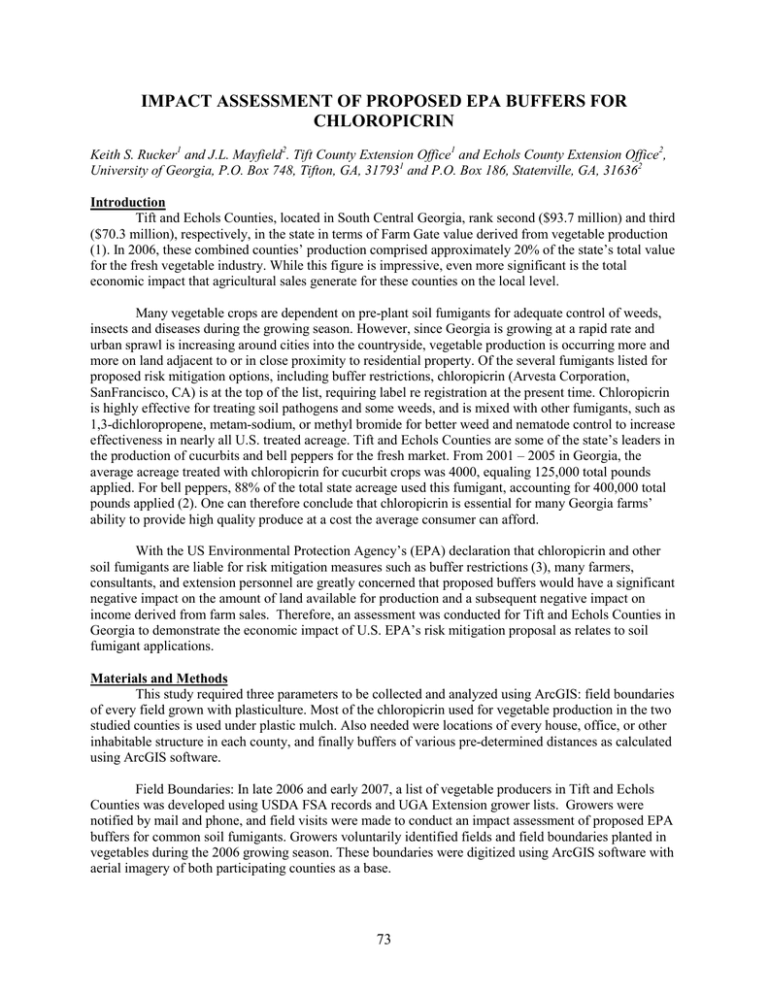IMPACT ASSESSMENT OF PROPOSED EPA BUFFERS FOR CHLOROPICRIN
advertisement

IMPACT ASSESSMENT OF PROPOSED EPA BUFFERS FOR CHLOROPICRIN Keith S. Rucker1 and J.L. Mayfield2. Tift County Extension Office1 and Echols County Extension Office2, University of Georgia, P.O. Box 748, Tifton, GA, 317931 and P.O. Box 186, Statenville, GA, 316362 Introduction Tift and Echols Counties, located in South Central Georgia, rank second ($93.7 million) and third ($70.3 million), respectively, in the state in terms of Farm Gate value derived from vegetable production (1). In 2006, these combined counties’ production comprised approximately 20% of the state’s total value for the fresh vegetable industry. While this figure is impressive, even more significant is the total economic impact that agricultural sales generate for these counties on the local level. Many vegetable crops are dependent on pre-plant soil fumigants for adequate control of weeds, insects and diseases during the growing season. However, since Georgia is growing at a rapid rate and urban sprawl is increasing around cities into the countryside, vegetable production is occurring more and more on land adjacent to or in close proximity to residential property. Of the several fumigants listed for proposed risk mitigation options, including buffer restrictions, chloropicrin (Arvesta Corporation, SanFrancisco, CA) is at the top of the list, requiring label re registration at the present time. Chloropicrin is highly effective for treating soil pathogens and some weeds, and is mixed with other fumigants, such as 1,3-dichloropropene, metam-sodium, or methyl bromide for better weed and nematode control to increase effectiveness in nearly all U.S. treated acreage. Tift and Echols Counties are some of the state’s leaders in the production of cucurbits and bell peppers for the fresh market. From 2001 – 2005 in Georgia, the average acreage treated with chloropicrin for cucurbit crops was 4000, equaling 125,000 total pounds applied. For bell peppers, 88% of the total state acreage used this fumigant, accounting for 400,000 total pounds applied (2). One can therefore conclude that chloropicrin is essential for many Georgia farms’ ability to provide high quality produce at a cost the average consumer can afford. With the US Environmental Protection Agency’s (EPA) declaration that chloropicrin and other soil fumigants are liable for risk mitigation measures such as buffer restrictions (3), many farmers, consultants, and extension personnel are greatly concerned that proposed buffers would have a significant negative impact on the amount of land available for production and a subsequent negative impact on income derived from farm sales. Therefore, an assessment was conducted for Tift and Echols Counties in Georgia to demonstrate the economic impact of U.S. EPA’s risk mitigation proposal as relates to soil fumigant applications. Materials and Methods This study required three parameters to be collected and analyzed using ArcGIS: field boundaries of every field grown with plasticulture. Most of the chloropicrin used for vegetable production in the two studied counties is used under plastic mulch. Also needed were locations of every house, office, or other inhabitable structure in each county, and finally buffers of various pre-determined distances as calculated using ArcGIS software. Field Boundaries: In late 2006 and early 2007, a list of vegetable producers in Tift and Echols Counties was developed using USDA FSA records and UGA Extension grower lists. Growers were notified by mail and phone, and field visits were made to conduct an impact assessment of proposed EPA buffers for common soil fumigants. Growers voluntarily identified fields and field boundaries planted in vegetables during the 2006 growing season. These boundaries were digitized using ArcGIS software with aerial imagery of both participating counties as a base. 73 Inhabited Structures: A point feature GIS layer for all E-911 address locations in Tift County was obtained from the Tift County GIS Department (Tax Assessors Office.) The layer showed the approximate point location for each E-911 address (inhabited structure) in the county. These locations included homes, businesses, churches, and any other locations where people assemble. The Field Boundary and Inhabited Structure layers were then overlaid in the GIS software. For Echols County, no E-911 address locations were ever digitized, so the county agent and farmers had to manually identify all structures surrounding their fields. Although this method was time-consuming, interest by farmers in both locations was high. Buffers: Buffers were calculated at 150, 300, 600 and 1200 feet distances around inhabited structures using the ArcGIS Buffer tool. Next, the area from each buffer that intersected a field boundary was clipped from the buffer regions using the ArcGIS Intersect Tool. The result was the total area for each buffer distance that fell within a vegetable field. Areas were calculated to determine the total acres impacted at each buffer distance. Lastly, ArcGIS calculated area (in acres) affected for all fields based on the various buffer distances. Results and Discussion Proposed buffers will negatively impact Tift and Echols County vegetable growers greatly in terms of reducing available land and total farm sales. Buffers of 150 feet, 300 feet, 600 feet, and 1200 feet would reduce available land in Tift County by 0.8%, 5.8%, 24.3%, and 60.6% respectively and subsequently reduce farm gate sales by $0.5, $3.5, $14.8, and $36.9 million dollars (Table 1). For Echols County, buffers of 150 feet, 300 feet, 600 feet, and 1200 feet would reduce available land by 0.5%, 5.7%, 27.8%, and 71.2% respectively and subsequently reduce farm gate sales by $0.3, $3.6, $17.6, and $45 million dollars (Table 2). One advantage of using ArcGIS to compile and report this type of data is that once this software has run the numbers on all associated fields, each farmer may obtain customized maps, with legends, of their own fields for their individual records and use. Files may be produced and printed for distribution to any who inquire. What can only be speculated here are some of the future unknowns. For instance, it is unknown whether the EPA will ultimately decide to use property boundaries as a base or stay with structures to determine starting points for buffer distances. If property boundaries are used, data from the local tax assessors office may be imported into ArcGIS, but it is estimated that when the software using these new boundaries as buffer starting points is run, far more land and farm value will be lost to the producer. Another unknown is whether current zoning laws will be favorable to producers. Currently, any land purchaser in these two counties may purchase land adjacent to a field and build a house on it. For farmers facing large buffer restrictions, this could potentially have a catastrophic effect on their ability to continue producing vegetables and income from that field. Lastly, it is unknown what the EPA will decide regarding mitigation procedures farms may have the option of using to assist with buffer requirements. For instance, if a particular fumigant requires a buffer of 600 feet, will some farms have the ability to decrease that requirement if it can be proven that fumigants were applied under a pre-determined range of favorable soil moisture, soil compaction, and wind values? Could these buffer restrictions be reduced if farms use virtually impermeable films (VIF), observe application block limits, etc. (3)? If some of these “good” agricultural practices (GAPs) are used to modify some of these buffer restrictions, they would benefit the vegetable producer greatly, and would 74 minimize the modifications, including field layout, irrigation zone changes, etc. he would have to make to keep farming his fields. Conclusions This study shows that certain proposed buffers will severely reduce available land for vegetable production in Tift County and Echols County, Georgia and subsequently reduce farm gate sales. The highest potential buffer examined in this study (1200 feet) would eliminate over 60% Tift County’s vegetable production and 70% of Echols’, costing farmers $81.9 million dollars in both counties combined, removing that income from the local economies. Such great buffer requirements would diminish the economic viability of agricultural land in both counties studied. These factors must be taken into consideration as buffer proposals are reviewed and implemented by government agencies. Additional impact assessments may be needed to determine long term affects of proposed field buffer restrictions on land values and residential growth. Literature Cited 1. McKissick, J.C. and S.R. Boatwright. 2006. Georgia Farm Gate Value Report (AR-07-01). Center for Agribusiness and Economic Development. University of Georgia College of Agricultural and Environmental Sciences, Athens, Georgia. p. 96. 2. Chism, B. 2007. Summary of the Benefits of Soil Fumigation with Chloropicrin in Crop Production (DP# 337501). Memorandum of the United States Environmental Protection Agency, Washington, D.C. p. 5. U.S. Environmental Protection Agency. 2007. Risk Mitigation Options to Address Inhalation Exposures from Soil Fumigant Applications. p. 3. http://www.epa.gov/oppsrrd1/reregistration/soil_fumigants/risk_mitigation.htm. Table 1. Effect of Proposed Buffers on Tift County Vegetable Production.______________________ Buffer Size Impacted Area Per cent of Total Impact on (feet) (acres) Acres Farm Gate Value__________________ 150 43 0.9 $537,144 300 283 5.8 $3,520,049 600 1194 24.3 $14,849,867 1200 2973 60.6 $36,978,687 Table 2. Effects of Proposed Buffers on Echols County Vegetable Production.___________________ Buffer Size Impacted Area Per cent of Total Impact on (feet) (acres) Acres Farm Gate Value__________________ 150 11 0.5 $315,876 300 132 5.7 $3,600,986 600 644 27.8 $17,562,702 1200 1649 71.2 $44,980,733 75







